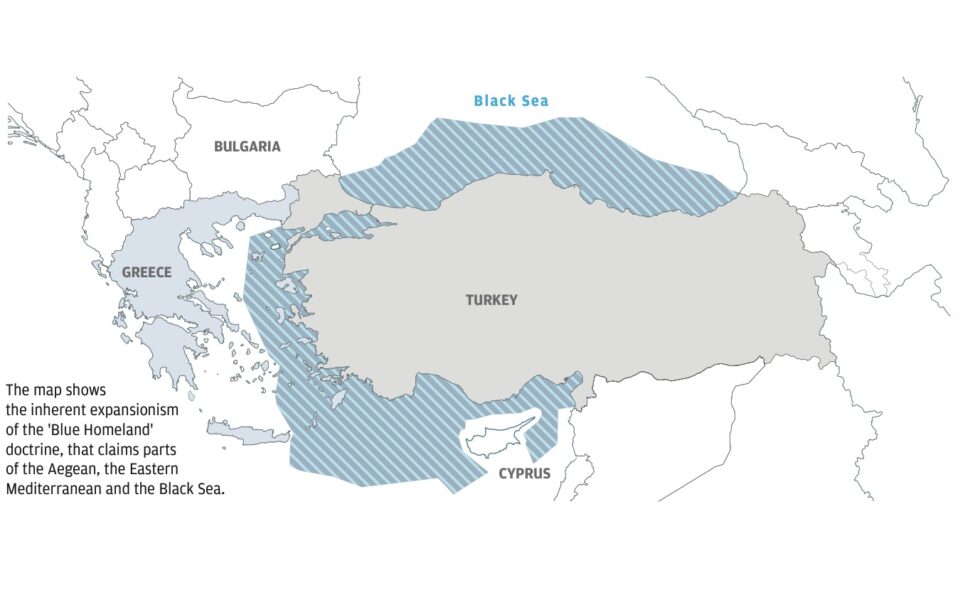Behind Turkey’s ‘Blue Homeland’ doctrine

Maritime space is a key element in contemporary Turkey’s geopolitical doctrine. However, the sea was never among the critical strategic priorities of the late Ottoman Empire nor of early Kemalist Turkey. Thus, despite the definitive loss of the Aegean islands enshrined in the 1923 Treaty of Lausanne, the treaty itself was initially perceived and treated in Turkey as a success and promoted domestically as such. This was also due to a significant extent to the Turkish nation’s historical identity as a land-based one. Even the nomadic character of the early Ottomans evolved into a settled farming/livestock-farming one and the pursuit of maritime dominance, mainly through Muslim pirates, was short-lived and was halted in 1571 by the Naval Battle of Lepanto (Nafpaktos).
From the beginning of the 1970s, however, this began to change. The development of the technical capacity for drilling for oil at sea, the discovery and exploitation of the Prinos field in the Aegean Sea and the United Nations process of drafting the Convention on the Law of the Sea mobilized Turkey’s political and military elites. Suddenly, Turkey claimed to be “suffocating” by the proximity to its shores of the Eastern Aegean islands and the Dodecanese under Greek sovereignty. Since then, Turkish strategy toward Greece has focused on “breaking the encirclement” and laying claim to half of the Aegean Sea.
The “Blue Homeland” is projected as a springboard for geopolitical claims and has quickly become extremely popular among the ranks of the Turkish Armed Forces. Senior officers of the Turkish Navy adopted and used the term “Blue Homeland” in 2006 to denote the need for Turkey to claim and defend a wide exclusive economic zone (EEZ), a priori challenging Greek sovereignty and Greek and Cypriot sovereign rights in the Aegean and the Eastern Mediterranean. At the same time, the jurisdiction of the international judicial bodies and thus the possibility of a judicial resolution of the Greek-Turkish dispute is rejected in principle.
It took more than a decade for “Blue Homeland” to be enshrined as a theoretical framework with strategic dimensions in the operational context of a major naval exercise. The Mavi Vatan 2019 exercise took place in the Black Sea, the Aegean and the Eastern Mediterranean in an impressive display of the Turkish Navy’s operational capabilities. Since then, Turkish President Recep Tayyip Erdogan has become the main, but not the only, exponent of the “Blue Homeland” and the concept is considered the foundation of Turkish regional activism, influencing Turkish military, political and economic elites, as well as a large part of the academic ones. Moreover, an extremely effective platform for the Turkish president that allows him to consolidate his alliance with the nationalist far-right at home and box in the opposition into a debate from which only he benefits politically as it leaves no room for questioning his “vision ” of a “New Turkey.” Erdogan thus becomes the “patriot-in-chief” in a patriotic nation.
The ‘Turkish Century’
The “Blue Homeland” ideology constitutes the integration into a holistic plan of Turkish claims on land and sea and is part of the promotion of Erdogan’s neo-Ottoman, that is, neo-imperial, agenda. It is about orchestrating modern Turkey’s return to the wider geographical areas where the Ottoman Empire historically influenced and dominated or upon which it claimed hegemony. The “Blue Homeland” is already being outflanked by the “Turkish Century” which is the magnifying glass of Turkish nationalism. It is well-known that Erdogan turned Kemalism’s traditional focus from, mainly, Europe (especially during the Cold War) toward the Muslim world, but also Asia, culturally, geopolitically, even economically.
In the Erdogan era, especially from 2013 onward, his country’s strategy acquired a “Eurasian” tone. Turkey no longer saw itself as on the periphery of the Western world but at the center of a large and critical geopolitical system. It was not enough for it to be a regional power; it wanted to impose itself as an inter-regional great power. Former prime minister and foreign minister Ahmet Davutoglu, with his well-known concept of “strategic depth,” attributed the decline of the Ottoman Empire to the loss of control of the seas and pointed out that for this reason Turkey should ensure a continuous and active presence of a military and commercial fleet from the Black Sea to the Red Sea; he later extended this presence to the Indian Ocean. He had proclaimed, in fact, that the Turkish governments which during the Second World War had left the islands of the eastern Aegean to the Greeks were unforgivable.
Davutoglu saw Anatolia as a hub connecting Europe, Africa and Asia. The Eastern Mediterranean plays a similar role in the “Blue Homeland,” as it connects the Mediterranean basin, the Middle East and the Indo-Pacific region. Although outside observers initially saw “Blue Homeland” as the expression of Turkish claims to energy reserves in the Eastern Mediterranean, the vision is transcontinental, if not global. Exploitation of natural resources is only one aspect of the plan, the ultimate goal of which is to control the eastern sea transit routes to Europe. The historical foundation of the doctrine is the position that, for Turkey to regain its deserved status, it must acquire sea power. The main obstacle to its implementation are the sovereign rights of Greece and Cyprus, which is why it is initially directed entirely against them.
The operational dimension
In addition to its theoretical dimension, the “Blue Homeland” is also meaningful at the operational level. Turkey, in addition to claiming a huge EEZ, envisions the interconnection with the geopolitical spaces outside the Eastern Mediterranean. So it has military facilities and presence in Qatar, Libya, Somalia, Syria, Iraq and of course there are the occupation troops in Cyprus. In the past 10 years it has acquired and used its own research vessels and drilling rigs without needing the technology and capabilities of third parties. Most important, however, is the ongoing shipbuilding program of the Turkish Navy that aims to meet the needs of the doctrine with national means and resources. More than 15 modern units will join the Turkish Navy by 2027, in addition to German-made submarines, the Anadolu helicopter carrier (which played such a prominent role in Erdogan’s re-election campaign) and naval joint action aircraft. Turkey, in short, is modernizing its navy and building naval power projection capabilities. Alfred Mahan, the famed US naval strategist of the late 19th century, is becoming relevant again.
Turkish analysts we contacted insisted that Ankara will not proceed to implement the “Blue Homeland” – besides the Turkish-Libyan memorandum (delineating maritime influence zones) which it will defend tooth and nail – but, through the concept it clearly projects its red lines in the Aegean and the Eastern Mediterranean. Those red lines proved to be flexible and vulnerable when Turkey could not react to the Greek-Egyptian demarcation agreement. Thus, “Blue Homeland” cannot be fully defended due to its maximalism and the opposition of other regional actors. However, when the “Blue Homeland” map depicts all the claims of the neighboring country unified under the “Great Idea” of the “Turkish Century,” even if six out of 10 Turks ignore it as a concept, they perceive those that put obstacles to its unfettered implementation as opponents and enemies.
The dangers
For Greece and the Republic of Cyprus, the big question is whether the “Blue Homeland” is a non-negotiable ideological project or a more flexible geostrategic preference that can be open to adjustments in the context of a regional settlement, subject to ultimately mutually tolerable compromises. In the first case, the scope for consultation and negotiation with the Turkish side is minimal. The “Blue Homeland” is primarily, if not exclusively, an absolute rejection of the Greek and Cypriot legal positions and a usurpation of sovereign rights, even the sovereignty of Hellenism. It is still an aggressive response to the “Maniatis Law” (a 2011 law named after the Greek deputy environment, energy and climate change minister of the time, Yiannis Maniatis, who introduced legislation delineating the Greek zones for oil and gas research) and the “Seville Map” (which delineates EU members’ EEZs), although the latter is not an official Greek position. It is also a response to various multilateral regional initiatives, which Turkey believes are aimed at marginalizing it. Therefore, having the “Blue Homeland” as its basis, Ankara seeks three things: first, not to be excluded from the allocation of resources and to have a say in most of the energy transport plans; second, to freeze the tripartite cooperation schemes in which Greece and Cyprus participate, with US blessings; third, to avoid being excluded from the cooperation schemes, security, energy and geopolitical ones, in the Eastern Mediterranean. Thus, for example, its offers to Cairo to entice it to cancel the demarcation agreement with Nicosia and accept a bilateral one with Ankara, as well as the Turkish-Libyan agreement, which confirm the above points.
In conclusion, Turkey sought through the intimidating maximalism of a map (the “Blue Homeland” map) that only it and some in Libya recognize, to overturn the unfavorable balance in the Eastern Mediterranean (having first let its relations with Israel and Egypt deteriorate) and to claim an upgraded leadership role.
Understandably, the stakes for Greece are fundamental because the “Blue Homeland” is directed against its vital interests. It potentially cuts it off from the Eastern Mediterranean, denies it any right to maritime zones east of the 25th meridian and effectively subjects the Greek islands to Turkey’s maritime jurisdiction! In this context, the strategic vision of the “Blue Homeland” is based on an inherently militaristic logic, which favors the use or threat of use of force. The “Blue Homeland” contains within it, provides ideological justification for, and updates the casus belli concept.
But even if Ankara does not intend to implement the “Blue Homeland” in the foreseeable future, even if it uses it to overcome what it perceives as an attempt to containing it, even if it is a negotiating tool for Turkey to join the negotiating table from a position of strength, the “Blue Homeland” is no less dangerous for us in the long run. Experience has shown that Turkey’s various novel theories, such as the “gray zones” (areas of unclear or disputed sovereignty), are consolidated and hardened over time. The “gray zones” have evolved from areas of so-called disputed sovereignty initially, have now become “Turkish.” The new claims are simply piled upon previous ones and complement them. With the “Blue Homeland” we now have a complete picture of Turkish claims. It is a nationalist, revisionist and aggressive ideology. A ticking time bomb, which the right alliances, our deterrent power and a tough and effective negotiation will disarm. As has happened in the past with the neighboring country’s claims, if we let them mature, they will be magnified, giving Turkey the confidence to create illegal faits accomplis, like the Turkish-Libyan pact.
Given these facts, what are Athens’ options? As long as Ankara does not abandon the maximalist character of the “Blue Homeland” doctrine, there is little room for optimism. The axes of the Greek strategy as formulated after 1974 are still completely valid. On the one hand, strong and modern armed forces at the service of a credible and economically viable deterrent doctrine. At the same time, partnerships and alliances that strengthen our diplomatic outreach and strengthen power factors, such as the economy. The second axis is an integrated plan of full normalization which will aim at neutralizing Turkish maximalism, in the service of the logic of mutual benefits. A difficult balancing act that Greek diplomacy has proven it can back up.
What the International Court has said about the issues raised by Ankara
The “Blue Homeland” is a mixture of claims designed to show how Turkey understands the use and delimitation of maritime zones. Of course, it does not claim closed-sea sovereignty, something that would run counter to the principle of freedom of the seas that Turkey so often invokes. At first sight it is necessary to clarify whether the islands are entitled to a maritime zone and how much. Because in the meantime Turkey has declared it will dispute the islands’ sovereignty as long as demilitarization, which, according to Turkish claims is a precondition of sovereignty, is not enforced. Additionally, the official maps are examined to see whether the islands’ maritime zones have been restricted, in case they lie too close to Turkey, to ensure that the Turkish coast enjoy sufficient maritime space. At some point, Turkey has claimed that the “equidistance” principle applies to demarcating maritime zones in seas such as the Aegean.
Ankara, using the Turkish-Libyan demarcation, considers itself not bound to negotiate with Athens to determine the areas of exercise of sovereign continental shelf/EEZ rights in the Eastern Mediterranean. In the Aegean, it highlights the requirement of unilaterally or bilaterally demarcating a continental shelf between the two mainlands. The islands for Turkey are either not entitled to a continental shelf or, because they lie on the “wrong side,” they are placed within the Turkish maritime zone. There is a third factor, that, because of their position, the islands prevent the coasts from projecting claims. All three cases have been decided by the courts. Regarding the first case – with the Nicaragua/Colombia decision (2012) – every island has rights, which by definition cannot be denied. Regarding the second, the same court has rejected the Turkish argument, because it has judged that no island can be “encapsulated.” The same applies mutatis mutandis (“once the necessary adjustments have been made”) to the third case. Therefore, Turkey cannot decide the fate of the islands in terms of demarcation, nor discount Greece’s claims, without a consensual settlement or a court decision.
Greece’s protest has created a dispute and Turkey has the obligation to negotiate the delimitation either by agreement or by court settlement. The court has emphasized that where coastal views overlap, unilateral delimitations for the exercise of sovereign rights are not permitted. Neither the filing of coordinates, or maps, constitute a substantive demarcation title, nor do they have inherent legal force; they merely demonstrate the filing party’ claims and their extent as understood by each individual state. Therefore, as long as there is a dispute, there is an obligation to refrain from unilateral continental shelf research actions, that is looking for natural resources, because they are an obstacle to the possibility of an agreement on delimitation. At the same time, both parties are bound by the Bern Agreement (moratorium, 1976), the validity of which they have never questioned.
Alexandros Diakopoulos is a former national security adviser to the Greek prime minister, a retired vice admiral of the Hellenic Navy and a consultant at the Hellenic Foundation for European and Foreign Policy (ELIAMEP). Petros Liakouras is a professor of international law and director of the International and European Studies postgraduate program at the University of Piraeus. Κostas Ifantis is professor of international relations at Panteion University and the director of the Institute of International Relations. Constantinos Filis is the director of the Institute of Global Affairs and associate professor at the American College of Greece.





